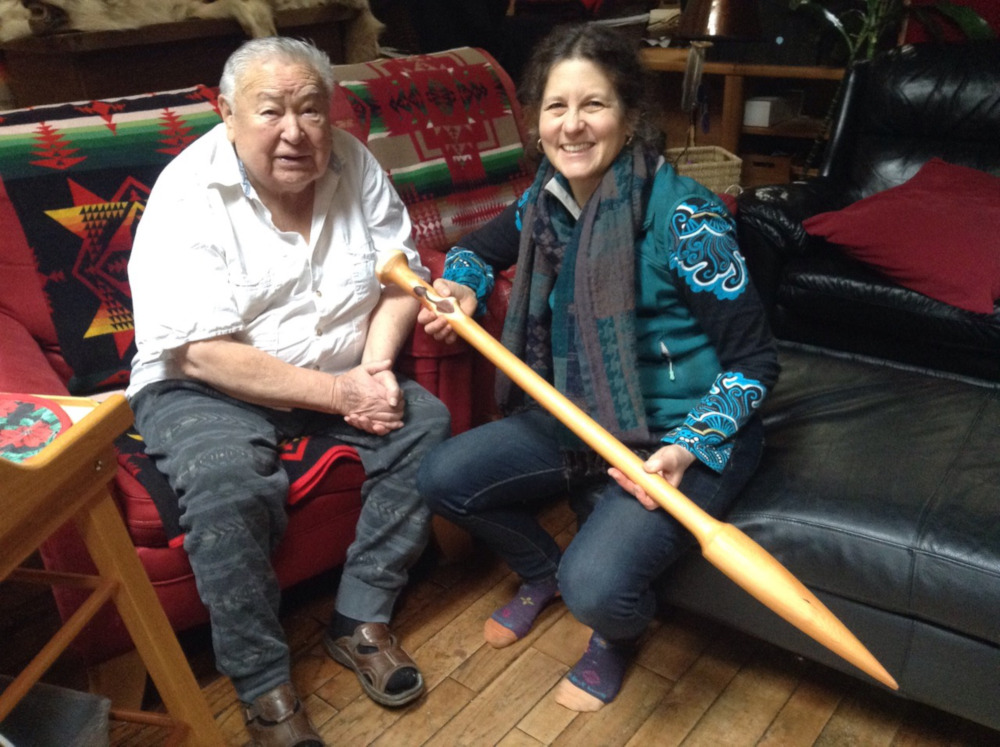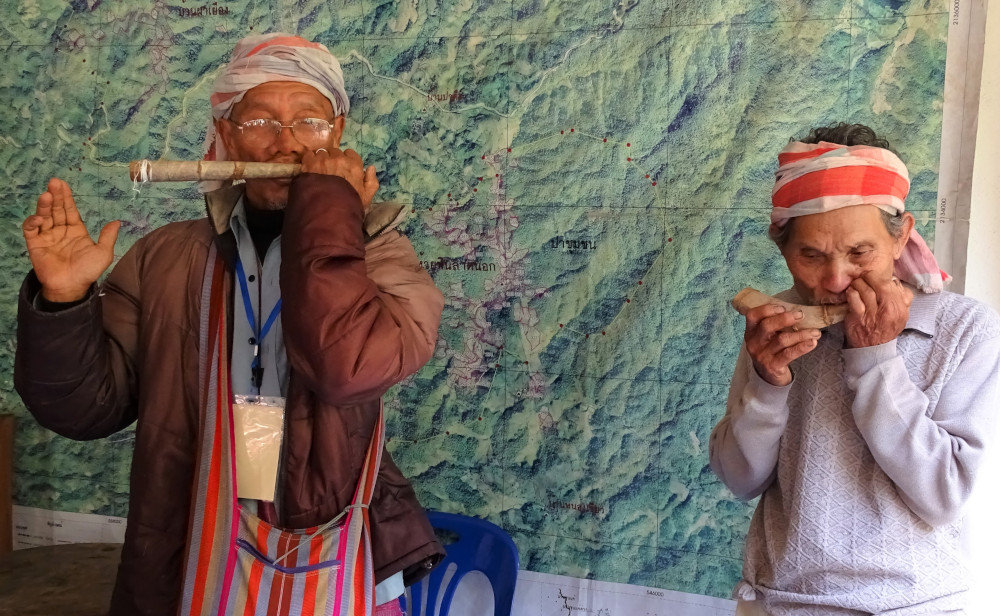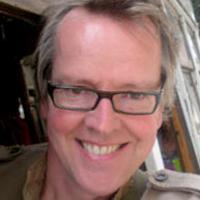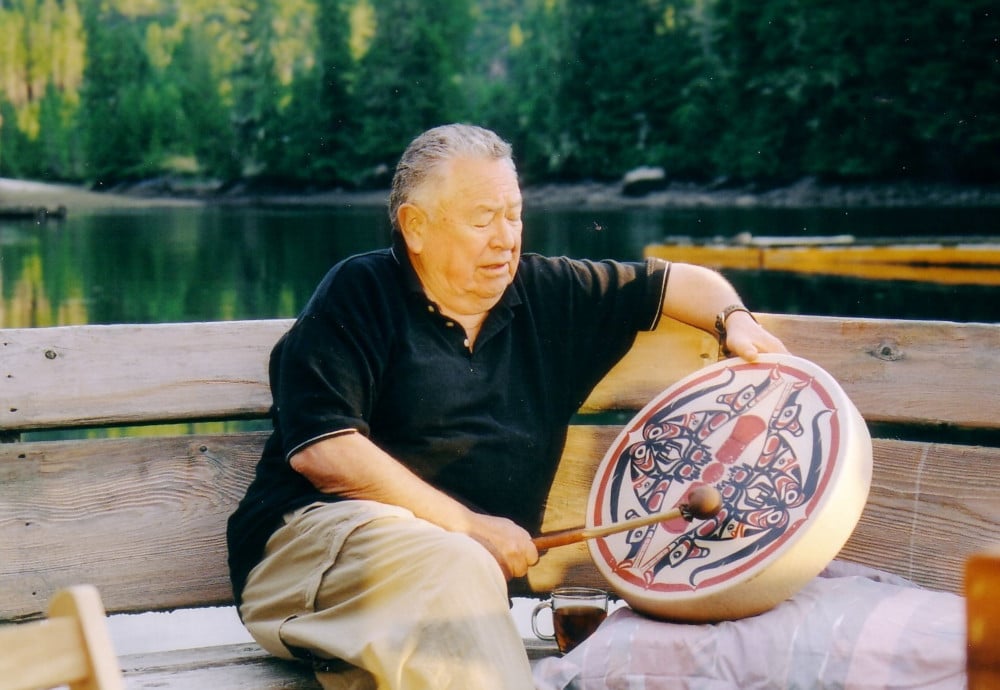As everyone knows, there are some things ethnoecologists simply don’t do. Study how people relate to their natural environment, yes; examine the ways in which natural world can shape culture, of course. But music? No. They don’t do music. That’s a different faculty. Different building.
Simon Fraser’s Dr. Dana Lepofsky may indeed have felt that way, once. But then Chief Adam Dick sang her a song.
Back in 2003 Chief Dick, also known as Kwaxsistalla from the Kawadillikall Clan of the Dzawatainuk Tribe of the Kwakwaka'wakw First Nation, was asked by geomorphologist John Harper, at the suggestion of ethnobotanist Nancy Turner about some unusual rock formations that had been found in the Broughton Archipelago, south of Haida Gwaii. “That’s just a lokiwey,” Kwaxsistalla told them.*
Then he began to sing. His song was about the lokiwey (clam garden), a traditional First Nations structure (either natural or constructed) used to facilitate clam harvests. The song he sang was not just a celebration but an explanation of how the lokiwey should be made and utilized, intended to teach succeeding generations how to go about it. It was like a Kwakwaka'wakw how-to manual set to music.
Later, meeting Adam to talk about lokiwey was certainly an education for Lepofsky. “Meeting Adam and hearing him sing was in many ways a turning point in my career,” she says now.
Kwaxsistalla’s song made her realize that she had been overlooking a valuable resource. “Adam knew hundreds of songs,” she says. “We’d just be sitting talking and he would start singing songs about the stars and the oolichan and things like that.”
Traditional songs have long been seen as cultural treasures worth preserving, but this was different. This was using music to uncover clues about how various peoples interact with the natural world. “Ethnomusicologists have been writing about this for decades,” says Lepofsky’s collaborator, Álvaro Fernández-Llamazares. “Not so much about the ecological context, but about the cultural context and what those songs mean. We added the biological part, the knowledge of species encoded in the songs.”
Initially inspired by Kwaxsistalla’s songs, Lepofsky and Fernández-Llamazares would go on to create and edit a special edition of the Journal of Ethnobiology (the terms ethnobiology and ethnoecology, Lepofsky says, are roughly interchangeable) focusing entirely on traditional songs. “Songs are storehouses for ethnobiological knowledge and practice,” they write in the introduction of Ethnobiology through Song, which collects research papers from Australia, Bolivia, Brazil, the Philippines, the U.S., southwest China, Cambodia, and elsewhere.
Although no scholar, I could perhaps have contributed a short article. It would be called: “How The Who Taught Me About Tea-Time.” As a kid listening to the album “The Who Sell Out,” I was puzzled by the song “Heinz Baked Beans,” a parody of a radio ad in which various family members are heard asking, “What’s for tea, Mum?” What could that mean, I wondered? As far as I knew, tea was nothing more than a hot beverage. What could it have to do with baked beans? The song was my first inkling that for Brits, “tea” could refer not just to a cuppa but also a meal.
Not exactly the same, but Lepofsky knows where I am coming from. It’s a matter of using music as a window into a way of life. For comparison she cites an essay in the journal co-authored by Fernández-Llamazares and Victoria Reyes-García about the Tsimane' people of Amazonian Bolivia. “They look at a corpus of songs that were collected and analyze those for information on hunting,” she says. “Where did people hunt, what did they hunt, when, what were the practices, what can we learn about the ecology of those animals?”
A little more complicated than “What does tea have to do with baked beans,” but similar.

Originally from Barcelona, Fernández-Llamazares has spent years in Bolivia with the Tsimane', helping to preserve and popularize their traditional music. That effort has included radio programs that broadcast Tsimane' music in the region. “I heard that there was interest in creating a special issue [of the Journal of Ethnobiology] on songs,” Fernández-Llamazares says. “And I stepped up to help with that.”
Once he and Lepofsky were put in touch, he says, “We instantly connected because we had so many interests in common.”
“We were surprised to find that not much had been done on ethnobiology and song. We were breaking a lot of new ground. Songs are a prism for looking at human-nature relationships. Songs are an important means of transmitting cultural information from generation to generation. Many of these traditions are being rapidly eroded due to cultural changes, globalization, the arrival of new musical forms and types of entertainment. There is less and less space for intergenerational exchange and transmission of knowledge. Those are trends we should be worrying about.”
“What’s really important,” Lepofsky says, “is that you don’t stop there, just with sharing that knowledge about peoples. You’re partnering with them to help bring those traditions forward. How do we perpetuate that knowledge? An ethnoecologist is almost always an activist as well. You can’t do this work and not be a raging activist — you have to realize that we’re at the eleventh hour in terms of bio-cultural diversity loss.”
The Tsimane' are particularly important for Fernández-Llamazares. “They have few written records and almost no access to mass media or scientific information,” he says. “So songs have traditionally played an important role in teaching. For example correct identification of species in the wild. Those songs tell you what different species look like. They explain hunting techniques, hunting tools, the norms and practices that you have to follow, which prayers you must make beforehand, which spirits you have to show gratitude toward. For Tsimane' children, songs are like an entry point into the hunting world. Songs are not enough to transmit all of the knowledge, but they are one of many mechanisms.”

Work involving traditional music must be done employing the highest ethical standards, he says. “You have to work with the community and for the community. So it takes a long period of time to make it happen. Otherwise we could be perpetuating colonial pasts, misappropriating knowledge collectively held by the Tsimane' community. So far it has worked very well but one needs to be very careful. I can tell you that it can work and this has given me hope.”
In addition to the radio series that broadcast Tsimane' songs throughout their region, Fernández-Llamazares has other plans to keep the musical traditions alive. “One of the things we are thinking of doing is bringing those songs into the school curricula in the Tsimane' territory. This is something that is not yet done.”
At SFU, Lepofsky also has plans to bring the subject into the classroom, perhaps with Fernández-Llamazares joining in via Skype. “I can’t wait,” she says. “We’ll probably start with songs in English, maybe songs of the Appalachian region. It will be different from looking at the music of the Tsimane' or music from other regions of the world — these being in English will be easier to tackle. I think students will relate to it and say, ‘Yeah, it makes so much sense. Language we knew about. The power of song is as great or greater.’”
While a sense of crisis hangs over this research, Fernández-Llamazares is hopeful too. “There’s an optimistic outlook to this story which is that many of these songs continue to be celebrated throughout the world,” he says, “and despite all the efforts that have been made by colonial powers to obliterate and suppress those traditions they are still there. That attests to the powerful bonds many of these communities have with their lands and culture, and that’s a beautiful story to tell.”
“Music is a powerful vehicle to express identity. We are not just losing the music itself, the melodies or the sounds. We are losing a complex way in which people articulate who they are and how they relate to their environment. It’s a world view, a way of understanding the world that would disappear if those traditions would get lost. But we will not let this happen.”
The special edition of the Journal of Ethnobiology is dedicated to Kwaxsistalla Wathl'thla Chief Adam Dick. The “Wathl'thla” part of that title essentially means “the late.” Chief Dick died last year from heart failure. But before his death he was able to pass along hundreds of songs of the Kwakwaka'wakw First Nation.
In part two of this story, tomorrow, his partner Kim Recalma-Clutesi, also known as Ogwiloqwa, speaks of the songs, power, and the legacy of Kwaxsistalla Wathl'thla, the late Chief Adam Dick.
Read the second piece in this two-part series here.
*Story updated at 10:40 a.m. on Oct. 29 to correct that the year Chief Adam Dick was asked about the unusual rock formations was 2003, not 2002. ![]()
Read more: Music, Science + Tech

















Tyee Commenting Guidelines
Comments that violate guidelines risk being deleted, and violations may result in a temporary or permanent user ban. Maintain the spirit of good conversation to stay in the discussion.
*Please note The Tyee is not a forum for spreading misinformation about COVID-19, denying its existence or minimizing its risk to public health.
Do:
Do not: